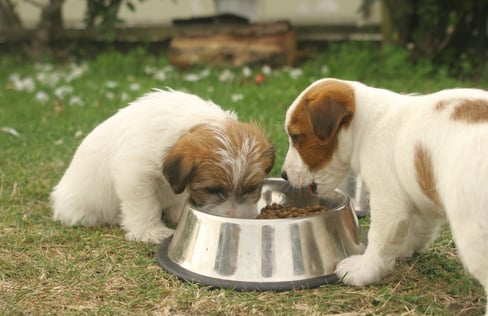Table of Contents
From masquerading as a lap dog to thinking they can somehow fit themselves onto a dog bed that’s much too small for their large frame, big dogs are not only silly; they have a lot of love (and laughs) to give.
Large breed dogs grow faster than their tinier counterparts due to their unique body structures and genetics. This means that their lifespans are not only shorter, but because their bodies get bigger quicker, our big puppies are more susceptible to potentially life-threatening health issues and other problems like joint pain simply because of their larger frames.
This information isn’t the most fun to learn, but it highlights the importance of taking excellent care of our big dogs from puppyhood into adulthood. You know that saying, “You are what you eat”? Feeding your big dog a nutritious diet is one of the best things you can do to help give your large puppy the best chance of living a long and healthy life.
In this article, we explore tips for how to take care of a large breed puppy and do a deep dive into how to choose the right large breed puppy food, from types, ingredients, the importance of high-quality protein, and more.
How to Take Care of a Large Breed Puppy
Big dog breed puppies are just like any other—they want to run, play, jump, and overall prove to the world that they can simultaneously be the goofiest and happiest creatures in existence. Your big puppy won’t let their size get in the way of trying to fit on your lap or “sneaking” into an unoccupied corner of the couch.
But big puppies have quickly growing bodies, so we need to take certain precautions as owners of large breed dogs to keep our big pups healthy and injury-free. Here are some important tips:
1. Feed a Daily Joint Supplement
Large breed puppies simply grow at a much faster rate compared to small breed dogs. A study that analyzed over 50,000 dogs from 74 breeds taken from the Veterinary Medical Database in North America found that large breed dogs have more of a gene called IGF1—a common growth hormone that’s found in tons of different organisms, including humans. This hormone is known to have a significant connection to aging, and large breed dogs have more of it than small breed dogs. This means that big dogs age faster, and that’s important for joint health because rapid growth rates can stress developing bones and joints, resulting in a greater chance of malformations.
Because large breed puppies experience a faster growth rate, they are more likely to get developmental orthopedic disease (DOD) and other bone and joint issues such as hip dysplasia and arthritis.
While there isn’t a way to 100% guarantee that your pup won’t ever have joint problems, there is a preventative measure that you can take to help them maintain their joint health, and that is giving them a daily dog joint supplement. The joint supplement helps strengthen your dog’s joint structures as they grow, helping their joints deal with their rapid growth rates more easily.
TRI-ACTA is a great choice for a dog joint supplement, as it contains essential ingredients as outlined in the table below:
|
Ingredient |
Benefit |
|
Glucosamine for dogs (HCl and sulfate) |
|
|
Chondroitin |
|
|
Methylsulfonylmethane (MSM) |
|
The ingredients listed above in TRI-ACTA are 100% natural and active ingredients in the supplement, meaning that the supplement contains absolutely no filler, preservatives, or additives.
TRI-ACTA for Pets
A proactive approach for developing and younger adult pets to maintain optimal joint health mobility, minimize inflammation and fend off age-related ailments.
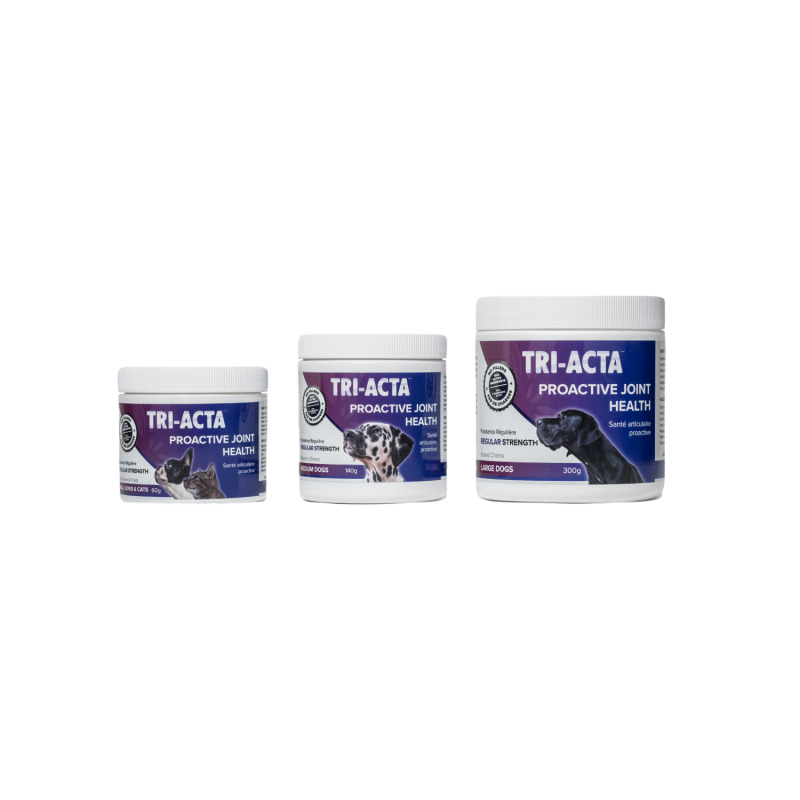
2. Provide a High-Quality Diet
Puppies need a balanced diet that includes the right mix of nutrients, protein, carbohydrates, and fat. In general, puppies need more calories compared to adult dogs because their little bodies are spending more energy growing and playing. However, care should be taken to not feed large or giant breed puppies too much food or food that is high in fat, as the extra bulk can cause significant stress on bones and joints that haven’t grown enough to accommodate it.
There are a number of recommendations that we’ll get into in a later section about what to look for in large breed puppy food, but in general, giant and large breed puppy food should:
- Contain both calcium and phosphorus, as these ingredients work together to support healthy bones and joints. The calcium/phosphorus ratio in your puppy’s food should be between 1.1:1 and 1.4:1. What this ratio means is that for every 1.1 to 1.4 parts of calcium, there should be 1 part of phosphorus in your pup's diet. This ratio is important because an imbalance in calcium and phosphorus levels can increase your pup’s risk of developing various health problems. For example, If the ratio is too high in favor of calcium (meaning there is significantly more calcium than phosphorus), it can lead to hypercalcemia, which can result in kidney stones, constipation, or interfere with the absorption of other minerals. On the other hand, if the ratio is too high in favor of phosphorus, it can lead to calcium deficiency, causing weakened bones and teeth.
- Contain vitamins and minerals to support skeletal development. Vitamin D, A, Copper, Zinc, and Manganese are essential for healthy bones and teeth. These vitamins and minerals must also be carefully balanced to support bone health. It’s important not to give your dog additional supplements if their food already contains these vitamins and minerals.
- Contain at least 22% high-quality protein and 8% fat. The amount of protein and fat for each serving of dog food should be listed on the package. We’ll learn more about what “high-quality protein” means in our section about what to look for in large breed puppy food, but in general, you should look for animal protein sources versus vegetable or plant sources.
3. Engage in Appropriate Exercise and Play
Because of the bone structure of large breed puppies, play that involves the dog running, jumping, and twisting their bodies to catch a ball or frisbee is not recommended, as the dog can easily injure themselves. This is because a large breed puppy’s body isn’t meant for quick pivots on the ground, and doing so can cause injuries to the shoulder, neck, and spine.
This isn’t to say that you can’t ever play fetch with your dog, but avoiding throwing a toy in the air where they have to jump and twist to catch it or too fast along uneven terrain are best practices to keep in mind to reduce the likelihood of injuries.
What to Look for in Large Breed Puppy Food
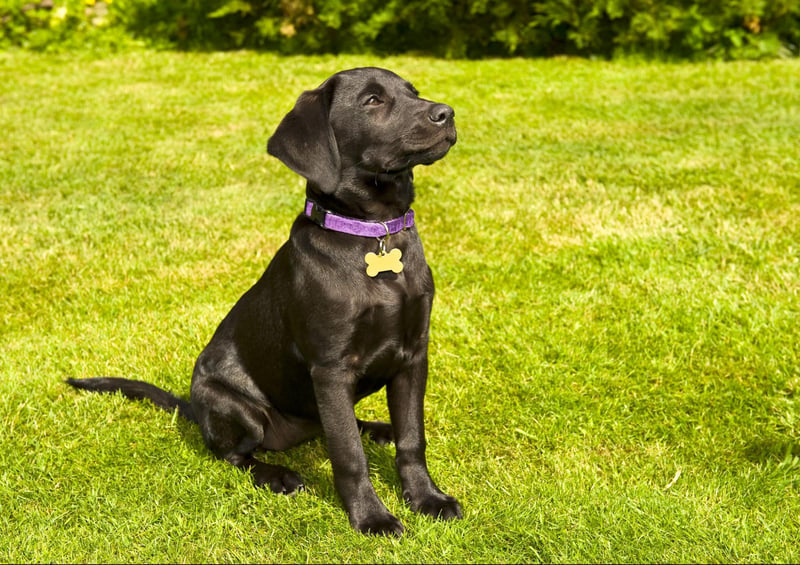
When it comes to choosing large breed puppy food, there are several important considerations that you should keep in mind. Many of these recommendations can be applied to any pet food you purchase, whether it’s for your large breed dog or another pet that you may have in your home. The recommendations below are compiled based on information from Regulators like the Association of American Feed Control Officials (AAFCO), The Pet Food Association of Canada (PFAC), and FEDIAF, an association representing the European pet food industry
1. Look for Food that is “Nutritionally Complete”
Commercial dog food, regardless of whether it is dry kibble, canned wet food, raw food, freeze-dried, or otherwise, should include a statement somewhere on its label that speaks to its “nutritional completeness” or adequacy to feed to your dog as its only source of nutrition.
The statement should include two main components:
- The life stage that the food is meant for. Puppies need different calories and fat compared to adult dogs. Therefore, the nutritional adequacy statement should clearly indicate whether the food is appropriate for puppies, adult dogs, or both.
- Whether it can be fed as a complete diet. Some dog treats can masquerade as dog food because they come in similar packaging. If the food is meant for supplemental feedings only (like treats) or is otherwise not meant to be fed on its own as your dog’s only source of nutrition, then the statement should say so.
If the dog food says that it is nutritionally complete, it contains the right balance of vitamins, minerals, and other nutrients that your dog needs in their daily diet. However, it’s important to remember the information we stated in the article about ratios of calcium and phosphorus and protein and fat and double-check the ingredients to ensure they also follow those guidelines.
2. Differences in Protein
Another important consideration when choosing large breed puppy food is the protein content, as well as the source of the protein. In general, animal protein is typically considered higher quality compared to plant protein, but when you look at dog food labels and see something like “meat by-product” or “meat byproduct meal” listed in the ingredients as sources of protein, it’s unclear what these mean from the names alone.
The table below lists the differences between types of meat or poultry protein that you will find in different types of commercially-produced dog food:
|
Protein Name |
Explanation |
|
Meat or poultry |
Refers to the animal's flesh. Meat or poultry in dog food may contain fatty tissues, sinew, gristle, or other components of the flesh. |
|
Meat byproducts or poultry byproducts |
Refers to organs, fatty tissues, and bones. With meat, byproducts do not include hair or fur, but with poultry, byproducts may include feet or heads. |
|
Meals |
Refers to blood, hair, fur, hooves, horns, skin, or hide. |
|
Byproduct meals |
As the furthest down the line of “meat products”, byproduct meals can contain stomach contents, feathers, and even manure. |
As you can see from the above table, the level of quality protein decreases as we move further down the list of meat-related ingredients. Choosing food with as many meat or meat byproduct ingredients as close to the top of the list as possible is a good practice for purchasing large breed puppy food.
3. High-Quality Ingredients Closer to the Top of the List
When it comes to how pet food manufacturers list the ingredients on their labels, the rule of thumb is that the ingredients that make up most of the food go in order from the first to the last ingredient. In other words, the best puppy food for large breeds will have their meat proteins listed as the first one to three ingredients, while the not-so-great options will have them buried further down in the list.
Common Types of Large Breed Puppy Food
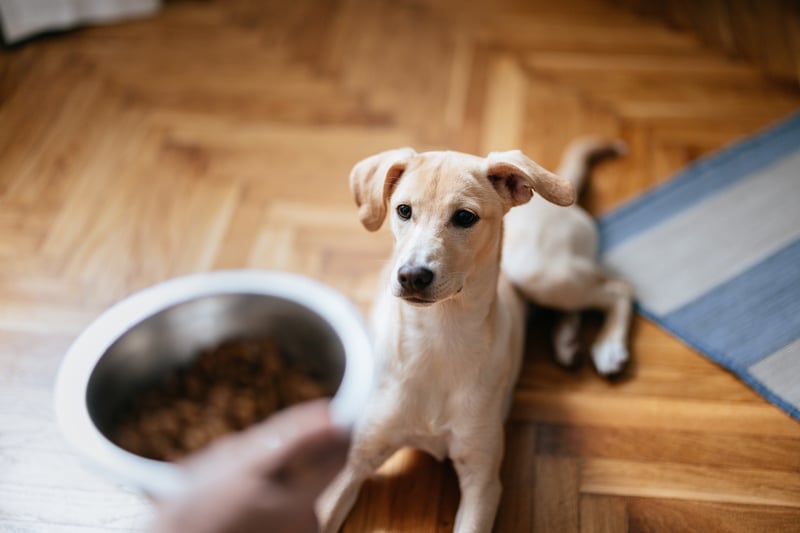
Now that we’ve gone through the basics of what to look for in large breed puppy food, let’s take a closer look at the best puppy food for large breeds you can give your dog. Many foods provide similar nutritional value, but dog owners may prefer one formulation over another. It’s important to remember that as long as your dog is getting the right balance of vitamins, nutrients, protein, carbohydrates, and fat in their diet, then they will be a happy and healthy dog no matter which type of food you feed them.
1. Dry Food or Kibble
Probably one of the most common commercially available puppy food for large breeds and small breeds alike is dry food, or kibble. Many pet owners enjoy purchasing dry food for their dog because it is easy to store and convenient to feed. Plus, dry food can be left out for longer periods of time compared to wet, raw, or cooked food without it becoming unsafe for your dog to eat. Typically, dry food designed for large breed dogs will have a bigger kibble size to accommodate larger mouths.
2. Canned Wet Food
Another popular commercially-produced dog food is canned wet food. If you’re raising a newborn puppy, canned wet food is a great first food choice for helping to wean the puppy off of their mother’s milk and onto solid food. Because canned wet food is soft, moist, and fragrant, puppies are typically more attracted to it than dry food. Plus, wet food is easier to eat for tiny puppies that don’t yet have that many teeth.
Unused canned wet food portions can be easily stored in the refrigerator for a few days until the portion is used. Usually, wet food comes in cans, so investing in a pet food can cover is a good idea to keep the food fresh and not have to worry about spills.
3. Freeze-Dried
Usually, freeze-dried dog food isn’t meant for a complete diet but rather given as a treat or a topper on other food. Freeze-dried dog food is typically just a meat product, like animal, poultry, or fish, without other additives. The process of freeze-drying the meat removes the moisture from the meat, preserving it enough that it can be stored for long periods of time without refrigeration. Because freeze-dried dog treats or food toppers typically don’t contain any preservatives or additives, they can be easily given to your dog separately from their food or mixed in.
4. Raw Food
A raw food diet for dogs has been specifically designed to engage the carnivore in your puppy by providing natural sources of meat, vitamins, and minerals through raw food rather than commercially processed options. The reason why some dog owners choose to feed their dogs a raw diet is because they’ve observed benefits to the dog’s overall health. In the linked study, a veterinarian states that one of the main benefits that they’ve noticed with dogs that eat a raw food diet is that allergies and digestive problems are often solved. This could be for a number of reasons, including that it’s easier to control the amount of ingredients in a raw food diet, therefore making it easier to eliminate allergens over time, and the limited ingredients result in easier digestion. Plus, raw food diets don’t have preservatives, fillers, or additives that could cause digestive problems in dogs.
If your dog has any medical issue that could be improved by a limited-ingredient diet, it may be worth looking into raw dog food. However, it’s important to ensure that your dog gets the right amount of vitamins, minerals, and nutrients in their diet, so it’s a good idea to consult a veterinarian or a nutritionist to develop a diet plan.
5. Cooked Food
Whether it be due to personal preference or ease of preparation, some dog owners prefer to feed their pup cooked food over raw. Aside from the obvious fact that the food is cooked, the other principles that apply to raw food also apply to cooked food: it can help with digestive issues and allergies and provide other positive health benefits for your pup.
With cooked dog food diets, there are a few important considerations to remember:
- Some dogs find cooked food more palatable than raw. If your dog turns up their nose at raw food, cooking it may entice them to eat.
- Food should be lightly cooked, not overcooked. This ensures that essential nutrients aren’t lost during the cooking process.
- Like raw diets, supplementation is usually necessary with cooked dog food diets to ensure that your dog gets the vitamins and minerals they need.
Best Puppy Food for Large Breeds
The best puppy food for large breed dogs should be nutritionally complete, have high-quality sources of protein as the main ingredients, and have a good balance of essential vitamins and minerals like calcium, phosphorus, vitamins A, D, copper, zinc, and manganese.
Here are our top picks for puppy food for large breed dogs:
Orijen Large Breed Puppy Food
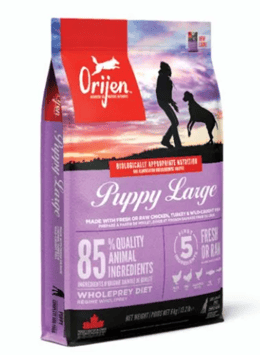
One of the most important considerations when choosing a large breed puppy food is the amount of high-quality protein ingredients. Orijen includes fresh or raw protein in the first five ingredients. In this case, the food contains chicken, turkey, herring, hake, and eggs. Plus, Orijen’s puppy food for large breed dogs has low levels of grain, which is preferable since grain is a common allergen for dogs. In addition, all the ingredients used in Orijen are created with only the highest quality Canadian ingredients. Although the food is a bit pricey, the high protein content means that your dog will likely get full faster, and you’ll need to feed less.
Starts at $69.99 CAD for a 6 kb (13 lb) bag. Pricing as of October 2023.
Nutrience SubZero Fraser Valley Puppy Food - Grain-Free
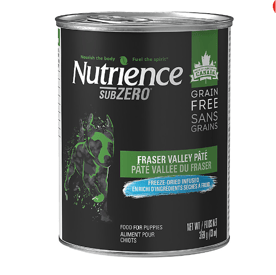
This grain free puppy food large breed option by Nutrience has a lot going for it. First, the ingredients pass the vibe check—chicken, chicken broth, chicken liver, turkey, salmon, and herring are the first six ingredients listed on the can. Aside from providing a nutritionally complete diet for your big puppy, Nutrience Sub Zero is made in Canada and infused with freeze-dried ingredients—meaning that your pup will get whole animal ingredients if they eat this food. You can choose to feed Nutrience Sub Zero as your dog’s entire diet or mix it with dry kibble to provide different textures and improve palatability.
$4.49 CAD for a 369 g can. Pricing as of October 2023.
Freshpet® Vital™Grain Free Beef & Bison Adult Dog Food
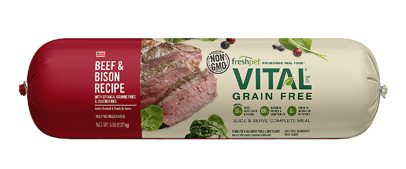
Let’s face it. Feeding a cooked diet can be tough, especially when you’re new to it and are having trouble navigating the particulars of ensuring that your dog gets the right level of nutrition. Freshpet provides an interesting solution to this issue by offering a lightly-cooked dog food option that is complete and balanced for all life stages, including puppies. It contains high-quality beef and bison protein and is grain-free. It also has no preservatives, meat meals, or byproduct meals. The packaging is important for the convenience of the product as well, as the tube allows you to simply slice and dice the amount that you need and store the rest in the fridge for up to 7 days. If you’re new to feeding a lightly-cooked dog food diet and want to start off slow with a commercial option, then Freshpet is a good choice.
Starts at $43.99 for a 5 lb tube. Pricing as of October 2023.
Conclusion
Choosing the right food for your large breed puppy is crucial for their overall health and well-being. Large breed dogs, due to their rapid growth, are more susceptible to joint problems and other health issues, making it essential for owners to provide proper care from puppyhood into adulthood. To ensure your big puppy lives a long and healthy life, it is important to feed them a nutritious diet, engage in appropriate exercise, and provide essential supplements like joint supplements to support their growing bodies.
One great option for a joint supplement is TRI-ACTA. With 100% natural, active ingredients with no fillers, additives, or preservatives, you can be sure that you’re giving your dog only the highest quality supplement available.
Purchase TRI-ACTA online or learn where to buy at a store near you.
TRI-ACTA for Pets
A proactive approach for developing and younger adult pets to maintain optimal joint health mobility, minimize inflammation and fend off age-related ailments.

Newsletter Signup
Subscribe to our newsletter to receive the latest news and exclusive offers.
.jpg?height=2000&name=Cliick_Integricare-DISPLAY-REVISEDV2%20(1).jpg)
Proactive & Therapeutic Joint Supplements
When given daily, Integricare joint supplements recover bone and joint injuries faster and help prevent mobility injuries from happening in the first place.








